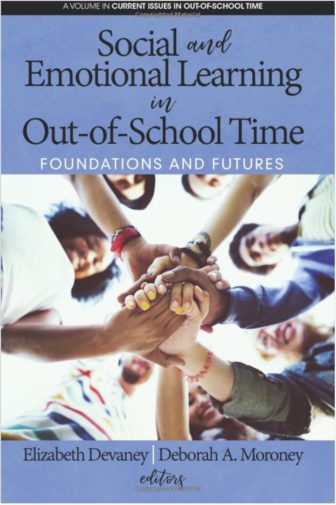
Ttyz/Shutterstock
.
“Social and Emotional Learning in Out-of-School Time: Foundations and Futures” is the second volume in the “Current Issues in Out-of-School Time” series (first was “The Growing Out-of-School Time Field: Past, Present, and Future”). This compendium of 17 information- and reflection-packed chapters is a major contribution to the growing literature in the field of out-of-school time through the lens of social and emotional learning.
The editors provide an up-to-date summary of practice, policy and research through articles from key leaders, providers and advocates of SEL in OST settings. The body of information is organized around critical topics for those interested in the history of SEL in OST, relevant examples of practice and key insights regarding policy, research and assessment. Highlights of the book’s five sections are below:

Social and Emotional Learning in Out-of-School Time: Foundations and Futures | Edited by Elizabeth Devaney and Deborah A. Moroney | Series: Current Issues in Out-of-school Time | Information Age Publishing | 2018 | 330 pages
In “Section I, SEL in OST: Backgrounds & Frameworks,” youth development is recognized as the founding and grounding framework of the OST field, and how SEL fits within a YD context is essential to explore. Dale A. Blyth takes us deeper into the challenges of blending YD, an approach to youth-driven practice and experience, with SEL, a process of building social and emotional competencies.
The metaphors of “caught” and “taught” are introduced to unravel important YD and SEL distinctions. YD programs dating back to the 1970s embody supportive environments, positive relationships and opportunities for experience where learning is “caught” by children and youth within nonformal education surrounds. In the formal educational structure that rules in schools, where SEL set its roots in the ’90s when the Collaborative for Academic, Social and Emotional Learning (CASEL) was established, knowledge and skills are most often described as being “taught” to the young through structured curriculum and teaching methods.
Blyth adds some critical insights for SEL in OST regarding the “challenge of helping youth develop their own ways of being while also understanding and respecting others’ ways of being.” OST programs may better respond to the lived experience of diverse students, their families and communities, including how race, class, gender and culture all mediate and impact SEL as well. We might then envision more culturally competent OST programs that better understand how and why the field can benefit from both YD and SEL.
Multiple alternatives
In “Section II, Research-Informed SEL Practice,” detailed examples of SEL from the field reveal the challenges and successes of multiyear OST program journeys. The presentation of multiple plans, models, programs, training, evaluation, funding and collaborations leave the reader encouraged, if not a bit overwhelmed. Programs presented include examples for pre-K-12 participants, city and statewide locations, after-school and summer activities, OST/school/community partnerships and more.
The diversity of programs and practices lets us know there is much room at the table for innovative strategies that can successfully support SEL for young OST participants over time. Most readers will identify with at least some familiar program and systems experiences, while being encouraged to learn from a number of evolving quality efforts. Many OST providers, I imagine, will find themselves taking notes on transformative program examples in order to support their own continuing SEL improvement strategies.
In “Section III, SEL Systems and Policy,” we are provided with a broader view of organizational and political happenings that have been forming and storming to support the investment in SEL at local, state and national OST levels. This includes examples from major organizing efforts in New York City, as well as from the Connecticut Afterschool Network and other statewide after-school networks (SANs) that receive funds from the Charles Stewart Mott Foundation, which support SANs in all 50 states.
Staff with the Afterschool Alliance, the nation’s largest OST communications and advocacy organization, provide an overview of strong public opinion in support of SEL and various federal policies regarding SEL in OST. Some important notes highlight the fragile and limited federal support for SEL in OST programming, such as in the Every Student Succeeds Act and Child Care Development Block Grants. Discussions in this section underscore the interface among partnerships, politics and funding, and serve to remind us of the critical need for continuing advocacy in support of SEL in OST.
Insights on measurement
In “Section IV, SEL Research, Measurement, and Assessment,” a field within the OST field is revealed. Thinking this would be the least engaging section for a YD practitioner like myself, I was relieved and motivated to want more from Gil Noam and colleagues with Harvard’s PEAR Institute than was revealed in their chapter on “The Measurement of Youth Social and Emotional Competencies in OST Settings.” Outlining the complexities of measurement in OST, where there is no clear consensus on “what” and “how” questions, this chapter provides some great insights and guidance.
The authors note the importance of moving beyond program evaluation called for by funders and policymakers to the continuous improvement opportunities that measurement can provide to help SEL in OST at the program level. They conclude, “We need to bring the same level of inquiry and reflection to our evaluation and assessment strategies that we hope educators will instill in our children during their OST activities.”
The book’s final “Section V, Conclusion,” is a reflective journey by youth development leader Karen Pittman with The Forum on Youth Investment. She makes the case (again) for purpose-driven work with young people. I was particularly moved by her passionate call for those in the youth work field to be leaders of SEL in OST today, with a few words of caution for a field that is “by name, tethered to K-12 education.”
Pittman is speaking to all youth workers today when she notes that “the pendulum has swung back to where we have always been — prioritizing the need to support children’s SEL.” I believe, as does she, that the articles in this book demonstrate that “we have the capacity to lead.” The wealth of experience and insights contained in this well-organized volume is well worth an investment of time and serious reflection — and may help motivate us to take up this important leadership role.
My only disappointment in reading this outstanding volume is that there is hardly a mention of another emerging educational movement that is inextricably linked to SEL: mindfulness education. As someone who has worked with colleagues in support of social, emotional and mindful learning for the past decade, I had anticipated some attention to mindfulness education’s contribution to SEL in OST and its impact on children and youth learning from the “inside out.” Here’s hoping a future volume in the “Current Issues in Out-of-School Time” series may do so. For those interested, a column on “Why social, emotional ‘and’ mindful learning?” provides some context.
Rick Alleva, Ed.D., serves on a Youth & Family Resiliency team at the University of New Hampshire. He is certified as a Master Professional through the New Hampshire Afterschool Professional Development System and provides training in social, emotional and mindful learning (SEML) and other youth behavioral health issues.



























